

BLUEPRINT. Mobile Maker Spaces. The production cart includes a tripod with iPad Pro mount, a piano keyboard, professional lighting, mics, headphones, and various items to help students produce movies, videos, and podcasts.

The concept was pretty straightforward, but the logistics were a bit complicated. We wanted to create four mobile maker space carts that could rotate among four middle school libraries in the Knox County School district of Knoxville, TN. It all started when our director of instructional technology, Theresa Nixon, encouraged us to apply for a TeacherPreneur Grant to fund a traveling maker space program. Our funding goal was approximately $50,000. Requesting this much money meant that we needed a an idea that dazzled. Our Makerspace Journey. The Stewart Middle Magnet School Library Makerspace Journey I first started my makerspace journey at Stewart Middle Magnet School in January 2014 with a few bins of K’nex spread out on some library tables.

Starting a School Makerspace from Scratch. With the National Week of Making behind us, you might be ready to start a makerspace in your school -- but not know where to start.

School Libraries and Makerspaces: Can They Coexist? More and more schools are coming to value maker education and exploring ways to create makerspaces in their schools.
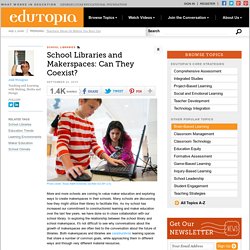
Many schools are discussing how they might utilize their library to facilitate this. As my school has increased our commitment to constructionist learning and maker education over the last few years, we have done so in close collaboration with our school library. In exploring the relationship between the school library and school makerspace, it's not difficult to see why conversations about the growth of makerspaces are often tied to the conversation about the future of libraries. Both makerspaces and libraries are constructivist learning spaces that share a number of common goals, while approaching them in different ways and through very different material resources. Similar Yet Distinct Makerspaces and libraries are sites of informal learning. Libraries and makerspaces are inherently interdisciplinary spaces. Makerspaces and libraries are more than just resource closets. A Librarian’s Guide to OER in the Maker Space.
Dynamic, living, breathing, current, personalized, adaptive, engaging, creative, cutting-edge, and current are just some of the words that have been used to describe the open educational resources (OER) movement.
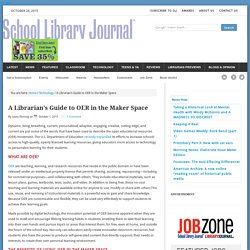
The U.S. Department of Education recently expanded its efforts to increase schools’ access to high-quality, openly licensed learning resources, giving educators more access to technology to personalize learning for their students. “Hatch” Library Maker Space in a Mall Draws DIYers, Students, and Entrepreneurs. A lightbox in the mall explains what Hatch is about.

Photo by Sarah Bayliss It’s a Tuesday evening and the Watertown (MA) Free Public Library’s (WFPL) maker space, Hatch, is humming. Volunteer Steve Small is demonstrating a 3-D printer and directing a steady stream of people toward the 3-D design class across the hall. A group of children dash in and head toward the bins of craft materials. In the back room, two men and a woman set up their laptops at a work table between the soldering station and the sewing machine. Located near the Dunkin’ Donuts in the town’s Arsenal Project Mall, Hatch, which had a soft launch in October 2014 and a grand opening in January 2015, supplies tools and materials to help users create a variety of projects from handmade to high tech.
Kids in creation mode at Hatch. ARMing a Breadboard — Everyone Should Program an ARM. Evolution of a Maker Space, From “Monstie Stuffie” Projects to a Giant Catapult. LittleBits activities at the circulation desk in Colleen Graves’s school library.
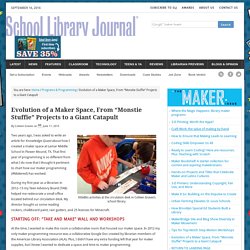
Two years ago, I was asked to write an article for Knowledge Quest about how I created a maker space at Lamar Middle School in Flower Mound, TX. That first year of programming is so different from what I do now that I thought it pertinent to chart how our maker programming (#Makered) has evolved. During my first year as a librarian in 2012–13 my Teen Advisory Board (TAB) helped me redecorate a small office located behind our circulation desk. Craft Work: the value of making by hand. Photo from iStock/Thinkstock Youth services librarians in public and school libraries have long relied on arts and crafts as a staple of storytimes and other programming.

These activities keep kids engaged, help develop fine motor skills, and are usually pretty fun. Crafting in groups adds a deeper dimension. Just like the quilting bees of old, a knitting or other handcraft group brings people together to share what they know. Coding Skills Empower Us All. Illustration by Marco Goran Romano We’ve all seen the hashtags: #code, #coding, #HourofCode, #LearnToCode, #programming.
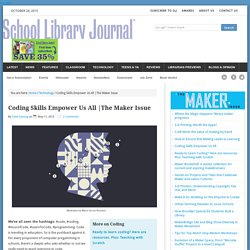
Code is trending in education. So is the pushback against it. For every proponent of computer progamming in schools, there’s a skeptic who asks whether or not we really need to teach everyone to code. Some other questions from the skeptic: Where does code fit in the school day and a traditional curriculum? We’re not coding in schools to make sure every kid gets a job in technology; we’re doing so to give all kids the chance to understand and interact with the technologies—including the social ones—in their lives. New Ideas for Better STEAM Programs. It was full STEAM ahead during the third week of SLJ’s online Maker Workshop.
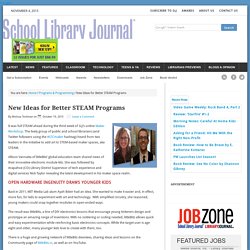
The lively group of public and school librarians (and Twitter followers using the #LTCmaker hashtag) heard from two leaders in the initiative to add art to STEM-based maker spaces, aka STEAM. Allison Vannatta of littleBits’ global education team shared news of their innovative electronic module kits. She was followed by Arapahoe (CO) Library District Supervisor of tech experience and digital services Nick Taylor revealing the latest development in his maker space realm.
Open hardware ingenuity draws younger kids Back in 2011, MIT Media Lab alum Ayah Bdeir had an idea. The result was littleBits, a line of DIY electronics lessons that encourage young tinkerers design and prototype an amazing range of inventions. There is a huge and growing network of littleBits devotees, sharing ideas and lessons on the Community page of littleBits.cc, as well as on YouTube. Make It Universal. Toy hacking during a DIYAbility workshop. Jim Tiffin was at an Edcamp STEAM in New Jersey a few years ago when he came across a session called Toy Hacks. A group of people were manipulating battery-operated toys. They were taking them apart, identifying the controls and switches inside, soldering an extra switch to each, and putting the toy back together. That way, kids with limited mobility could play with the toys. A Thematic Approach to Planning Your Maker Space. When schools talk about the Maker Movement and creating maker spaces, they often focus their initial thinking on purchasing the tools and materials.
Sphero Goes Crystal Clear with SPRK, a New Version of the Programmable Robot. Anyone who has played with a Sphero—one of the maker movement’s robotic darlings—has surely wondered what was inside. To bystanders, the programmable ball might appear to have a life of its own, but a series of mechanisms help the electronic ball to turn, flash, even flip along the course specified through its suite of apps. The new 2.0 version, the SPRK, lets users peek inside the previously opaque shell to see the gears and circuits driving its motions.
SPRK extends the gadget’s learning potential through command-line access to a range of scripts, which promise to help fledgling coders hone their skills by spelling out exactly what will trigger an action and what form that action will take. The SPRK has a transparent polycarbonate shell, but proves every bit as resilient as the 2.0 hardware. Like the earlier Sphero, it uses induction rather than plug-in charging.